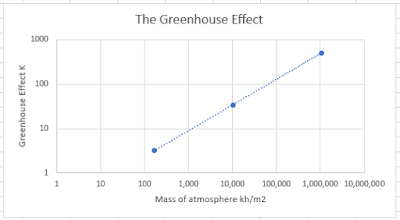This will be one of the first chapters in my book, if I ever get round to writing it.
1. Work out total mass of atmosphere of Mars, Earth and Venus per m2 (divide surface pressure in Pascal N/m2 by acceleration due to gravity m/s2).
2. Work out 'effective temperature' (based on incoming radiation W/m2, albedo of surface/cloud cover, Stefan-Boltzmann constant 5.67/10^8).
3. Work out lapse rate (acceleration due to gravity m/s2 ÷ specific heat capacity of constituent gases based on temperature at hard surface J/K/kg)
4. Work out hard surface temperature by adding lapse rate x altitude of "mean radiating altitude" (which to all intents and purposes is the same as the average altitude of cloud cover, that being the first thing the solar radiation interacts with when it hits a planet and the thing which on which albedo is based).
5. Look up actual average surface temperature in K and make sure it tallies with your answer 4.
6. Plot the results for all three planets using logarithmic axes and add a line of best fit.
7. Oh my, it's all a straight line. Which is what you'd expect anyway:

8. It's a shame that our estimates for the total mass of the Gas Giants and their temperature at the core i.e. their hard surface are so vague, it would be nice to see if they fit the pattern.
